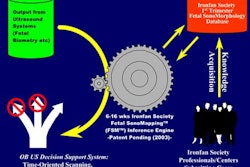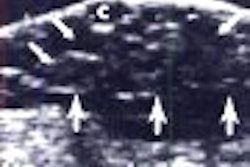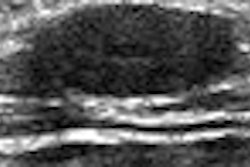Performing fetal anatomic surveys on follow-up antepartum sonograms can contribute to the discovery of unforeseen fetal anomalies, according to an article published in the September issue of the Journal of Ultrasound in Medicine.
"Fetal anatomic surveys on follow-up sonograms may identify unanticipated fetal anomalies and may give an opportunity for neonatal intervention, especially when the indication is for fetal growth," wrote a Houston research team from Methodist Hospital, St. Joseph Medical Center, and Southwest Community Health Clinic.
To evaluate the clinical usefulness of a fetal anatomic survey during follow-up antepartum sonograms, the team performed a retrospective follow-up study at a low-risk maternity clinic from July 1, 2005, and June 30, 2006. Women with at least one prior sonographic exam beyond 18 weeks' gestation with a complete and normal fetal anatomic assessment and at least one follow-up sonogram were eligible for the study (JUM, September 2007, Vol. 26:9, pp. 1175-1179).
Ultrasound was performed using a Logiq P5 scanner (GE Healthcare, Chalfont St. Giles, U.K.) with a 3.5- to 5-MHz curvilinear probe. All exams were performed by one sonographer, and sonographic studies were interpreted by one of two sonologists. Both the sonographer and sonologist were aware of the findings of the first sonogram, according to the authors.
Of the 4,269 sonographic examinations performed during the study period, 437 (10.2%) were repeat studies. The researchers elected to exclude 101 (23.1%) of these repeat studies because the initial sonogram revealed a suspected fetal anomaly, as well as 42 (9.8%) of the studies because the initial sonogram had an incomplete fetal anatomic assessment, showed a multiple gestation, or was performed at less than 18 weeks' gestation.
Of the 294 follow-up studies, 21 (7.1%) had an unanticipated fetal anomaly, 19 of which were renal pyelectasis. There was also one ventricular septal defect (VSD) and one cleft lip.
The researchers also noted that when compared with follow-up sonography for other reasons, the incidence of fetal anomalies was higher when the indication for repeated sonography was for fetal growth. Anomalies were found in 15 of 122 (12.3%) patients with a fetal growth sonography indication, compared with six of 172 (3.5%) in patients with other indications (p = 0.01).
"The study suggests that follow-up sonography may help identify fetal anomalies that develop later in the second or third trimester," the authors wrote.
The researchers acknowledged the weaknesses of their study, including its retrospective design and likely insufficient sample size to make definitive recommendations for practice changes. Also, the study population may not necessarily be generalized to other populations, as 95% of the patients were of Hispanic ethnicity and a lower socioeconomic background, they explained.
Nonetheless, the research showed that fetal anatomic surveys in this application may identify unanticipated fetal anomalies, according to the study team. This was especially true when the indication was for fetal growth.
"This investigation suggests that further studies may be necessary to gain perspective in this area," the authors concluded.
By Erik L. Ridley
AuntMinnie.com staff writer
August 24, 2007
Related Reading
GA-oriented morphology boosts fetal US malformation workup, August 9, 2007
Fetal entertainment ultrasounds draw patient interest, March 20, 2007
Early prenatal ultrasound inadequate for detecting congenital heart malformations, June 30, 2006
Empty renal fossa on prenatal ultrasound indicates renal ectopia or agenesis, August 17, 2005
Fetal ear length may indicate chromosomal abnormality, April 11, 2002
Copyright © 2007 AuntMinnie.com



















